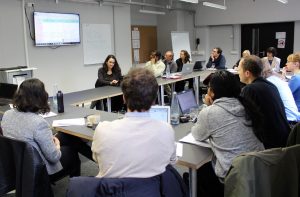– written by Christian Schneider (University of Leipzig) and Sabine Kraushaar (University of Vienna) –

Group of Critical Physical Geography Scientist from around Europe. Organizers left frist row: Prof. Rebecca Lave (Indiana University) and behind her Prof. Stuart Lane (Université de Lausanne).
In March this year the first European Critical Physical Geography (CPG) Workshop took place in Berlin bringing together 19 scholars from different European and American research institutions and backgrounds under the lead of Rebecca Lave and Stuart Lane and the financial support by their affiliations Indiana University and the Université de Lausanne.
The workshop intended to:
(i) support the exchange between scientists who follow – or want to follow – a critical approach in their research,
(ii) create a legible base for their proposals and
(iii) promote the ideas.
But let’s start slowly first – What is CPG?
CPG research aims at “critical attention to power relations with deep knowledge of biophysical science or technology in the service of social and environmental transformation” (Lave et al. 2013).
So far scholars who consider themselves part of CPG are engaged in hydrological modeling, geomorphology, critiques on ecosystem services assessments, food sciences, timber production and land use change assessments. Most of the works are influenced by political ecology, science and technology studies, integrative approaches in geography as well as systems theory and critical approaches from political and human geography.
Additionally the workshop made clear that for many scholars in Europe CPG means as well:
- a space to discuss scientific and activist approaches to dismantle power relations embodied in biophysical systems and/or the perspectives on as well the use of biophysical systems, rather than a new scientific discipline next to political ecology, human geography, physical geography etc.
- a cooperative and integrative platform to critically reflect on the own work in physical geography as well as in other natural sciences.
- a school of thought influenced by critical geographical thinkers like David Harvey, Doreen Massey and Neil Smith.
- Scholars in CPG might also consider themselves as part of societal decision making rather than an objective scientists only providing facts to stakeholders.

Session on the intellectual roots of CPG? How is CPG different from existing interdisciplinary research traditions, such as socio-ecological systems? How is it different from political ecology?
An elementary question of the workshop was how to transform science into CPG research?
Firstly, we as scholars who are interested in CPG need to reflect which epistomologies and onthologies are used in our fields of research, and what kind of knowledge counts and who benefits from the knowledge and data we are producing. Following these considerations, one might stumble over research questions that do not only focus on the measurement of slope instabilities and natural hazards in a certain area but ask for the political and economic factors influencing the spatial distribution of these hazards. Or who suffers from it in what way? Moreover, it became clear that CPG is hard to imagine without a transdisciplinary approach. Many will say at this point that they include stakeholders already in their research through leaflets, presentations or a homepage. However, CPG meant for all the participants that we allow the researched to “talk back to us” and include stakeholders in a way that they are not only informed but actually shape the way how research is done, this way valuing local knowledge and researching an actual demand beside the fundamental interests in a research object.
Let’s put critical into physical geography!

Discussing How do we actually do this? How can we embed critical perspectives in physical models? How can we investigate the co-constitution of eco-social systems? What are the material substances through which structural inequalities are (re)produced?
Most – if not all – of our current environmental challenges cannot be fully understood from only one disciplines perspective. In order to understand urging problems of our time we need to know about the relevant processes and flows of matter and energy as well as about the structures of power which cause and shape the impacts of biophysical phenomena. We need to understand and incorporate critical social and political geographical approaches to analyze social power relations in order to design new critical approaches and foci to assess biophysical systems.
And a lot of work has been done already if we look at Political Ecology, Critical Geography as well as the discourses about a social-ecological transformation and DeGrowth.
The CPG workshop in Berlin also fed into recent attempts to establish a more natural science oriented branch of Critical Geography during the annual meetings of the Critical Geography Network in Germany. Therefore, feel free to contribute to the Research Workshop for Critical Geography 2017 in Bremen or the current initiative to organize a Conference on Critical Geography in Tübingen this year. If you are interested in this topic let’s have a meeting at the EGU 2017 and let’s think about a session on critical physical geography at the EGU 2018.
Interested? Please feel free to contact us!
Christian Schneider: Christian.Schneider@uni-leipzig.de
Sabine Kraushaar: Sabine.Kraushaar@univie.ac.at
– written by Christian Schneider (University of Leipzig) and Sabine Kraushaar (University of Vienna) –
